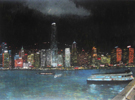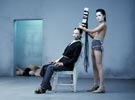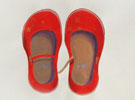Did Dada philosophy appeal to you?
Dadaism, or any “ism” in the world, is born out of a certain environment for certain reasons. Whether it develops or dies immediately after it comes into being, each “ism” is a phenomenon of “life”. Only a few manage to develop into a mainstream phenomenon.
Any art movement is related to some prior movement; it does not matter where it is from. Movements take a positive or negative stance on movements that preceded them; some are simply a change of claim or statement based on that of their predecessors. Art movements are like the tides, like a tsunami: they originate in the water, wind, and the changing of the seasons.
What influences your working style and artistic themes?
Colorful life experiences, the land, and the passage of time. I am a dreamer, and always have been. It has “plagued” me since childhood.
What is your view of contemporary art?
Art today is like a haunted house, with every artist hoping to “shock” the other ghosts. However, there are so many ghosts, large and small, young and old, even some not yet born. In the information era we live in, it is extremely difficult to shock the world; even if Picasso, van Gogh, Gaudí or Dalí came back to life, they would only be a group of small ghosts in a huge crowd of phantoms.
But on the other hand, art today is like wild flowers during the rainy seasons—not one can proudly claim to be unique. Only through comparison with the others does one stand out as more yellow or blue, and the field more colorful for it.
I never wanted to create anything “shocking.” It is against my nature to do so intentionally. If someday someone somewhere says there is something “shocking” about me, they must be talking about a bird dropping a seed from the bending tree in the splendid field bellow. I am not destined to be a part of the mainstream or a follower; I am just a bending tree in the field.
How did you arrive at the idea of the Earth Nest?
At the beginning of 1996, I was in urgent need of a studio of my own. “I feel the need to enclose myself for a while. I do not want to play around in other people’s walls, so I have to build a wall around myself.” My intuition told me that I did not need an ordinary building, but rather a sculpture, a work of art. Whether it was good or bad, tall or short, I just needed a wall that would shut me out of the world for a while. That is how everything started. The nest became my prison for ten years, but it was also my escape, my paradise. For ten years, happiness and suffering cohabited side by side.
At the beginning of 1996, I drafted a few blueprints, none of which were satisfactory. In August, after one glance, my seven-year-old son pointed at my “design” and boldly declared: “This house is no good.” He then drew three drafts, freehand, which joined together were to become my studio—“the Earth Nest.” The drawings awoke memories of childhood: they were the child's intuition I had been looking for.
The father decided to build the studio as casually as the son had drafted it, because only by feeling the way and doing it casually could final harmony be achieved. I tried to hire contractors, but without drawings, calculations, or even a budget, the engineers refused to work on it. I was proven right in the end though—casual construction is the way to go when working with casual design. Although workers ran away en masse during the construction process, self-confidence, experience and arrogance enabled the buildings to shoot up like bamboo after the rain.
In the beginning, I had 10 mu (0.667ha) of land, on which I traced a round perimeter with a 3m-long bamboo pole, simply planning to build a small studio. However, as I grew more and more excited and impulsive, the circle got larger and larger, and soon it exceeded the pre-established dimensions of the building. I had undertaken a matter of considerable financial risk and played with it like the clay of my childhood. It was for fun; as for the rest, we would have to wait and see. As construction progressed, the bank saw I was a not just a man of words, but a man of action, and they granted me a loan. Thanks to the injections of funds, I was able to hire hundreds of workers and construction was completed 300 days.
The crimson bricks of the porcelain factory chimney, the mound-like kilns, and four years as a construction worker had given me an everlasting and intimate love of bricks. It got its name—the Earth Nest—from the earth it rose out of. The “nest” idea came from our building techniques which resembled those of birds. Bricks in my hands were just like tree branches in a bird’s beak: birds wove their materials together, and so did I; they did not have any structural problems, so neither should I. The only difference was that I wove them into a larger nest and owed money to the bank; birds do not have that problem; they only have to worry about making a nest large enough for their family.
How did you finance such an ambitious project?
My enthusiasm and fervor always came at a cost. In August 1997, I appointed myself general manager and chef of a restaurant. For a person who had been cooking since the age of six, it was no big deal to run a restaurant seating 2,000. I purchased all the facilities and made the bowls and dishes myself, and was ready to receive guests from all over the world. I hung a sign over the door that read: “On the menu: culture; on the program: art.” For a time, customers came in droves to wine and dine while watching ethnic song and dance performances from Yunnan.
Unfortunately, people were interested in going out to flashy restaurants only to fill their bellies, and my little sign “On the menu: culture; on the program: art” was out of synch with the times. No wonder returning customers would complain, “We are here to eat and drink! We want good food and wine! Take away the bloody culture and arts!” Three years of hard work in the arts and catering business turned out to be a loss. The “Earth Nest” restaurant closed down in May 2000. Outraged, I broke or sold everything, dismissed some 70 staff, and went back to farming.
Since the restaurant closed, the majority of visitors have been my friends in Chinese and overseas arts and culture circles and their friends. But since 2002, the peripheral circle has been growing bigger, attracting Chinese and overseas entrepreneurs, movie stars, government officials, students, doctors, factory directors, workers, farmers, real estate agents, collectors…even the occasional thief. What makes me the most proud is when a visitor compliments my cooking.
This small-scale communist-style commune has seen so many happy days. Some of the visitors have become good friends. Each has been supportive in their own way. I sincerely feel that “each friend is a drop of water, which can help the seed to turn to green.” Their ways of life also form an artistic source of inspiration for my art.
You must have been devastated when the project failed.
I was about to smash myself like I had smashed the pots and pans. Fortunately, I still had dreams. All means of retreat had been cut off, yet I was not finished quite yet; I would keep on going. The spring of 2001 came round, waking me up along with the trees in my garden.
Two months after all operations had been suspended in May 2000, my assistant, Yang, told me that a sheep farmer next door had brought a donkey home and was about to kill it to sell the meat. Upon hearing the news, my heart contracted, “Go and buy it. I'll keep it here,” I said. It was a little male donkey, which I named “Luo Hui” (Luo the Gray). Since then, he has accompanied me through days of solitude and perplexity. We often bathe in the sun together, talk to each other, and dine at the same table together outdoors. Actually, we are very much alike. Not only do we look alike, but we share similar personalities. Donkeys prefer carrying heavy loads. If the burden on its back is not heavy enough, it cannot run. I have had the same habit since childhood: I cannot get going unless the weight on my shoulders is heavy enough.
When did you start achieving commercial success?
It is hard to say. The concept of “commercial success” is very vague, particularly in the art market where so many games are played. When can you say a seed is successful? Once it is planted in the earth? When it sprouts, when it blooms, or when its peaches are sold as gold balls in the market? If the tree cannot tell when it succeeds, neither can I.
Is the ego an important aspect of the creative personality?
Total egocentrism is a type of psychosis and selfishness. Buddha once said, “Open up your hand, and the world will be yours. Close your hand, and you will have nothing.” Self-centeredness is like closing the hand and for an artist, if the hand is closed too tightly, nothing else can enter except oneself. Then how can you generate something new? It is impossible. Personally I do not accept the word “creation.” Only heaven and earth are capable of “creating.” Human beings are a small part of creation, too small to even be noticed. What is creation then? The clever and perspicacious Picasso once said, “Art lies in discovery.” He did not dare to speak of creation.
What are your thoughts about the future?
I think my future will be like that of the trees I have planted.
13 February 2006










